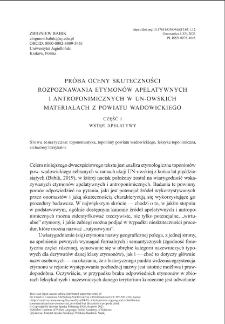
Object
Title: An attempt to assess the degree of effectiveness of assigning apellative and anthroponomical etymons to toponyms of the Wadowice district as confirmed in the late 1950s: Part one: introduction, appellatives
Publisher:
Instytut Języka Polskiego Polskiej Akademii Nauk
Place of publishing:
Description:
Abstract:
The paper is the first part of a larger study aiming at characterizing toponyms of the Wadowice district (Małopolska Voivodeship, southern Poland), an area so far regarded as more densely populated only in late Middle Ages or later, on the basis of its etymons, both appellative and anthroponymical. Only names confirmed in the course of data collection in the late 1950s were taken into consideration. The main question to be answered is to what extent the procedures identifying etymons of geographical names currently used by toponomasticians can prove both effective and accurate. In this part of the study, attention was focused on appellative etymons. A list of such items has been compiled, containing words attested in the major dictionaries or collections of the Polish lexis, as well as archaisms reconstructed solely on the basis of related toponyms. Some of the latter ones are discussed at some length in the body of the paper; some have been preserved in their topographical meanings in other Slavic languages (*čelo ‛precipitous slope’ metaph., *čьrtorъja ‛valley’, *xobotъ ‛river bend’ metaph., *sъbojь in various meanings, derivative *svьrkъl- ‛(dwarf) spruce’ locally distorted to *ćwierkiel), others remain mere reconstructions, sometimes encountered in the toponymy of other parts of Poland as well (*gorěńь ‛burned forest”, *pertiŕь ‛path?’) or even endemic to that area (*nesъlnь ‛shaded place?’, *pobedr- ‛slope?’, *prik(ъ)ŕaznь ‛precipitous slope’, *ryšь -a -e ‛reddish’; *tьlčanь ‛valley?’ metaph.). The only few unattested terms can be easily explained as Polish in origin (e.g. *gorьnica ‛upper part of a village etc.’). To sum up, the 20th century toponymy of this area is characterized by a notable lack/paucity of more archaic native derivational models (no structures in *-ьsko, *-ьno or *-yni), but at the same time by a surprisingly large number of Slavic lexical archaisms preserved in place names.
Relation:
Volume:
Issue:
Start page:
End page:
Detailed Resource Type:
Format:
Resource Identifier:
click here to follow the link ; oai:rcin.org.pl:233479
Language:
Language of abstract:
Rights:
Terms of use:
Copyright-protected material. May be used within the limits of statutory user freedoms
Access:
Object collections:
- Institute of Polish Language PAS
- Institute of Polish Language PAS > Filds of science
- Institute of Polish Language PAS > Serials
- Institute of Polish Language PAS > Filds of science > Humanities
- Institute of Polish Language PAS > Filds of science > Humanities > Linguistics
- Institute of Polish Language PAS > Filds of science > Humanities > Linguistics > Onomastics
Last modified:
Feb 3, 2022
In our library since:
Feb 2, 2022
Number of object content downloads / hits:
141
All available object's versions:
https://rcin.org.pl/ijp/publication/270592
Show description in RDF format:
Show description in RDFa format:
Show description in OAI-PMH format:
Objects Similar
Babik, Zbigniew
Babik, Zbigniew

 INSTYTUT ARCHEOLOGII I ETNOLOGII POLSKIEJ AKADEMII NAUK
INSTYTUT ARCHEOLOGII I ETNOLOGII POLSKIEJ AKADEMII NAUK
 INSTYTUT BADAŃ LITERACKICH POLSKIEJ AKADEMII NAUK
INSTYTUT BADAŃ LITERACKICH POLSKIEJ AKADEMII NAUK
 INSTYTUT BADAWCZY LEŚNICTWA
INSTYTUT BADAWCZY LEŚNICTWA
 INSTYTUT BIOLOGII DOŚWIADCZALNEJ IM. MARCELEGO NENCKIEGO POLSKIEJ AKADEMII NAUK
INSTYTUT BIOLOGII DOŚWIADCZALNEJ IM. MARCELEGO NENCKIEGO POLSKIEJ AKADEMII NAUK
 INSTYTUT BIOLOGII SSAKÓW POLSKIEJ AKADEMII NAUK
INSTYTUT BIOLOGII SSAKÓW POLSKIEJ AKADEMII NAUK
 INSTYTUT CHEMII FIZYCZNEJ PAN
INSTYTUT CHEMII FIZYCZNEJ PAN
 INSTYTUT CHEMII ORGANICZNEJ PAN
INSTYTUT CHEMII ORGANICZNEJ PAN
 INSTYTUT FILOZOFII I SOCJOLOGII PAN
INSTYTUT FILOZOFII I SOCJOLOGII PAN
 INSTYTUT GEOGRAFII I PRZESTRZENNEGO ZAGOSPODAROWANIA PAN
INSTYTUT GEOGRAFII I PRZESTRZENNEGO ZAGOSPODAROWANIA PAN
 INSTYTUT HISTORII im. TADEUSZA MANTEUFFLA POLSKIEJ AKADEMII NAUK
INSTYTUT HISTORII im. TADEUSZA MANTEUFFLA POLSKIEJ AKADEMII NAUK
 INSTYTUT JĘZYKA POLSKIEGO POLSKIEJ AKADEMII NAUK
INSTYTUT JĘZYKA POLSKIEGO POLSKIEJ AKADEMII NAUK
 INSTYTUT MATEMATYCZNY PAN
INSTYTUT MATEMATYCZNY PAN
 INSTYTUT MEDYCYNY DOŚWIADCZALNEJ I KLINICZNEJ IM.MIROSŁAWA MOSSAKOWSKIEGO POLSKIEJ AKADEMII NAUK
INSTYTUT MEDYCYNY DOŚWIADCZALNEJ I KLINICZNEJ IM.MIROSŁAWA MOSSAKOWSKIEGO POLSKIEJ AKADEMII NAUK
 INSTYTUT PODSTAWOWYCH PROBLEMÓW TECHNIKI PAN
INSTYTUT PODSTAWOWYCH PROBLEMÓW TECHNIKI PAN
 INSTYTUT SLAWISTYKI PAN
INSTYTUT SLAWISTYKI PAN
 SIEĆ BADAWCZA ŁUKASIEWICZ - INSTYTUT TECHNOLOGII MATERIAŁÓW ELEKTRONICZNYCH
SIEĆ BADAWCZA ŁUKASIEWICZ - INSTYTUT TECHNOLOGII MATERIAŁÓW ELEKTRONICZNYCH
 MUZEUM I INSTYTUT ZOOLOGII POLSKIEJ AKADEMII NAUK
MUZEUM I INSTYTUT ZOOLOGII POLSKIEJ AKADEMII NAUK
 INSTYTUT BADAŃ SYSTEMOWYCH PAN
INSTYTUT BADAŃ SYSTEMOWYCH PAN
 INSTYTUT BOTANIKI IM. WŁADYSŁAWA SZAFERA POLSKIEJ AKADEMII NAUK
INSTYTUT BOTANIKI IM. WŁADYSŁAWA SZAFERA POLSKIEJ AKADEMII NAUK
































